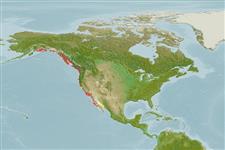Teleostei (teleosts) >
Syngnathiformes (Pipefishes and seahorses) >
Syngnathidae (Pipefishes and seahorses) > Syngnathinae
Etymology: Syngnathus: Greek, syn, symphysis = grown together + Greek, gnathos = jaw (Ref. 45335).
More on author: Girard.
Environment: milieu / climate zone / depth range / distribution range
Ecology
Marine; brackish; demersal; depth range 0 - 5 m (Ref. 96339). Subtropical; 61°N - 22°N, 150°W - 109°W
Eastern Pacific: Sitka, Alaska to southern Baja California in Mexico; the northern population ranges from Alaska to Monterey Bay, southern population from Morro Bay southward.
Size / Weight / Age
Maturity: Lm ? range ? - ? cm
Max length : 32.5 cm TL male/unsexed; (Ref. 93899); 38.5 cm TL (female)
Common in eelgrass of bays and estuaries, sometimes taken in shallow offshore waters (Ref. 5316). Feeds on crustaceans (Ref. 6885). Females larger than males (R.C. de Graaf, pers. Comm., 2001; Ref. 93899). Ovoviviparous (Ref. 205). The male carries the eggs in a brood pouch which is found under the tail (Ref. 205).
Life cycle and mating behavior
Maturities | Reproduction | Spawnings | Egg(s) | Fecundities | Larvae
A female wraps herself around a male in a rigid vertical S position. Eggs are fertilised in the brood pouch of the male (Ref. 6885).
Eschmeyer, W.N., E.S. Herald and H. Hammann, 1983. A field guide to Pacific coast fishes of North America. Boston (MA, USA): Houghton Mifflin Company. xii+336 p. (Ref. 2850)
IUCN Red List Status (Ref. 130435)
Threat to humans
Harmless
Human uses
Fisheries: commercial; aquarium: public aquariums
Tools
Special reports
Download XML
Internet sources
Estimates based on models
Preferred temperature (Ref.
123201): 8.3 - 18, mean 10.2 °C (based on 254 cells).
Phylogenetic diversity index (Ref.
82804): PD
50 = 0.5000 [Uniqueness, from 0.5 = low to 2.0 = high].
Bayesian length-weight: a=0.00027 (0.00013 - 0.00055), b=3.18 (3.01 - 3.35), in cm total length, based on LWR estimates for this species & Genus-body shape (Ref.
93245).
Trophic level (Ref.
69278): 3.2 ±0.40 se; based on food items.
Resilience (Ref.
120179): High, minimum population doubling time less than 15 months (tmax=2;).
Fishing Vulnerability (Ref.
59153): Low to moderate vulnerability (29 of 100).
